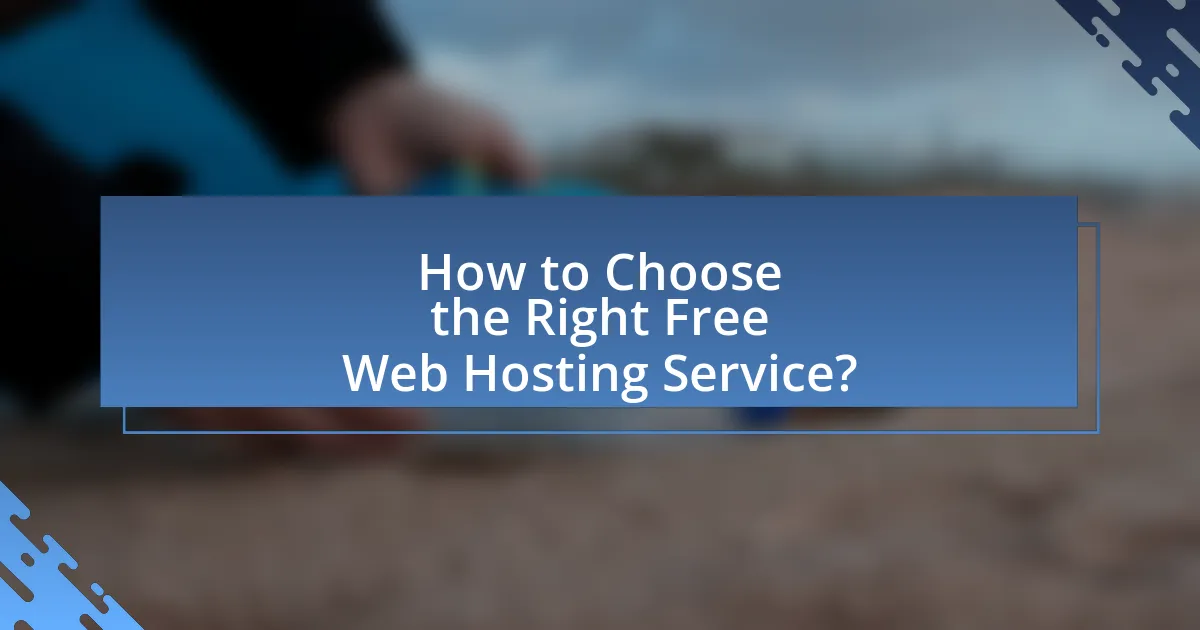Free web hosting for portfolio websites or blogs is a cost-effective solution that allows users to publish content online without financial investment. This article explores the differences between free and paid hosting options, highlighting the limitations of free services, such as restricted storage and bandwidth, and the lack of customer support. It also discusses the benefits for beginners, the various types of free hosting services available, and popular platforms like WordPress.com and Wix. Additionally, the article provides guidance on choosing the right hosting provider, setting up a website, and maintaining optimal performance, while addressing common challenges and best practices for promoting online presence.

What is Free Web Hosting for Portfolio Websites or Blogs?
Free web hosting for portfolio websites or blogs is a service that allows users to publish their content online without incurring any costs. This type of hosting typically offers limited storage space, bandwidth, and features compared to paid hosting options. Many providers, such as WordPress.com and Wix, offer free plans that enable users to create and manage their portfolio or blog with basic functionalities, often supported by advertisements or branding from the hosting service. According to a 2021 report by HostingAdvice, approximately 30% of new websites are launched using free hosting services, highlighting their popularity among individuals and small businesses looking to establish an online presence without financial investment.
How does free web hosting differ from paid hosting options?
Free web hosting differs from paid hosting options primarily in terms of features, reliability, and support. Free hosting typically offers limited storage, bandwidth, and functionality, often displaying ads on user sites, while paid hosting provides more resources, enhanced performance, and customer support. For instance, a study by HostingAdvice in 2021 indicated that paid hosting services generally ensure 99.9% uptime, compared to the often unreliable uptime of free services, which can be as low as 80%. Additionally, paid options allow for custom domain names and advanced security features, which are usually not available with free hosting.
What are the limitations of free web hosting services?
Free web hosting services have several limitations, including restricted storage space, limited bandwidth, and lack of customer support. These services often impose caps on the amount of data that can be stored and transferred, which can hinder website performance and accessibility. Additionally, free hosting typically includes advertisements on users’ sites, which can detract from the professional appearance of portfolio websites or blogs. Security features are often minimal, increasing vulnerability to cyber threats. Furthermore, users may not have access to custom domain names, which can affect branding and credibility. According to a study by HostingAdvice, 70% of users reported dissatisfaction with the limitations of free hosting, highlighting the common challenges faced by individuals relying on these services.
How can free web hosting be beneficial for beginners?
Free web hosting can be beneficial for beginners by providing a cost-effective platform to learn web development and design skills. This allows newcomers to experiment with website creation without financial risk, enabling them to understand essential concepts such as domain management, content management systems, and basic coding. According to a survey by HostingAdvice, 70% of new website owners reported that free hosting helped them gain confidence in their abilities before investing in paid services. This hands-on experience is crucial for building a portfolio or blog, as it allows beginners to showcase their work and gradually transition to more advanced hosting solutions as their skills and needs grow.
What types of free web hosting services are available?
There are several types of free web hosting services available, including shared hosting, website builders, and cloud hosting. Shared hosting allows multiple users to share server resources, making it cost-effective for personal websites and blogs. Website builders, such as Wix and Weebly, offer user-friendly interfaces for creating websites without coding knowledge, often including free hosting as part of their service. Cloud hosting provides scalable resources and is suitable for users who may need more flexibility as their website grows. Each type serves different needs, making it essential for users to choose based on their specific requirements for portfolio websites or blogs.
What are the most popular platforms for free web hosting?
The most popular platforms for free web hosting include WordPress.com, Wix, Weebly, and GitHub Pages. WordPress.com offers a user-friendly interface and a variety of themes, making it ideal for blogs and portfolios. Wix provides drag-and-drop functionality and customizable templates, appealing to users seeking design flexibility. Weebly also features a simple drag-and-drop editor, along with e-commerce capabilities. GitHub Pages is favored by developers for hosting static websites directly from GitHub repositories, allowing for version control and collaboration. These platforms are widely recognized for their ease of use and accessibility, making them suitable for individuals looking to create portfolio websites or blogs without incurring costs.
How do different free hosting services compare in terms of features?
Different free hosting services vary significantly in terms of features, with key differences in storage, bandwidth, support, and customization options. For instance, WordPress.com offers 3 GB of storage and a user-friendly interface but limits customization unless users upgrade to a paid plan. In contrast, Wix provides a drag-and-drop builder with 500 MB of storage and 1 GB of bandwidth, making it suitable for beginners but also restrictive in terms of storage. Additionally, InfinityFree offers unlimited storage and bandwidth, appealing to users needing more resources, but lacks customer support, which can be a drawback for those requiring assistance. These comparisons highlight that while some services prioritize ease of use and support, others focus on resource availability, catering to different user needs.
Why should you consider using free web hosting for your portfolio or blog?
Using free web hosting for your portfolio or blog allows you to establish an online presence without financial investment. This option is particularly beneficial for beginners or those testing ideas, as it eliminates the barrier of hosting costs. According to a 2021 survey by Statista, 40% of small businesses reported that budget constraints were a significant factor in their online strategy, highlighting the importance of cost-effective solutions. Free web hosting platforms often provide essential features like templates and easy-to-use interfaces, enabling users to create and manage their content efficiently.
What are the advantages of using free web hosting for personal projects?
Using free web hosting for personal projects offers several advantages, including cost savings, ease of use, and accessibility. Cost savings are significant as individuals can launch websites without financial investment, making it ideal for hobbyists or those testing ideas. Ease of use is another advantage, as many free hosting services provide user-friendly interfaces and templates, allowing users to create and manage their sites without technical expertise. Accessibility is also enhanced, as free web hosting allows anyone with an internet connection to share their projects with a global audience. These factors make free web hosting a practical choice for personal projects.
How can free web hosting help in building an online presence?
Free web hosting can significantly aid in building an online presence by providing accessible platforms for individuals and businesses to showcase their work without financial barriers. This accessibility allows users to create portfolio websites or blogs, which can attract visitors and potential clients. According to a 2021 survey by Statista, over 70% of small businesses reported that having a website increased their visibility and credibility. By utilizing free web hosting, users can establish a digital footprint, enhance their brand recognition, and engage with a broader audience, ultimately contributing to their online presence.

How to Choose the Right Free Web Hosting Service?
To choose the right free web hosting service, evaluate the features, reliability, and limitations of each option. Key factors include storage space, bandwidth, uptime guarantees, and customer support. For instance, services like InfinityFree offer unlimited storage and bandwidth, while others may impose strict limits. Additionally, consider the ease of use and whether the platform supports the technologies you need, such as WordPress or HTML. Research user reviews and ratings to assess reliability; for example, a service with a 99.9% uptime guarantee is generally more dependable.
What factors should you consider when selecting a free web hosting provider?
When selecting a free web hosting provider, consider factors such as storage space, bandwidth, uptime reliability, and customer support. Storage space determines how much content you can host, while bandwidth affects the amount of data transferred to and from your site. Uptime reliability is crucial, as a provider with high uptime ensures your website remains accessible; for instance, a provider with 99.9% uptime guarantees minimal downtime. Customer support is essential for resolving issues quickly, and providers that offer 24/7 support are preferable. Additionally, check for limitations on features like ads, domain names, and scalability options, as these can impact your website’s growth and user experience.
How important is uptime and reliability in free web hosting?
Uptime and reliability are critically important in free web hosting, as they directly affect the accessibility and performance of portfolio websites or blogs. High uptime ensures that visitors can access the site without interruptions, which is essential for maintaining user engagement and trust. According to a study by the website monitoring service Pingdom, even a 1% downtime can lead to a loss of 24 hours of accessibility per year, potentially resulting in lost traffic and revenue. Therefore, reliable hosting services are vital for anyone looking to showcase their work effectively online.
What role does customer support play in choosing a hosting service?
Customer support is crucial in choosing a hosting service as it directly impacts user experience and problem resolution. Reliable customer support ensures that users can quickly address technical issues, which is vital for maintaining website uptime and functionality. According to a survey by the HostingAdvice team, 70% of users prioritize customer support quality when selecting a hosting provider, highlighting its importance in decision-making. Effective customer support can lead to higher satisfaction and retention rates, making it a key factor in the overall success of a hosting service.
How can you evaluate the features of different free hosting options?
To evaluate the features of different free hosting options, compare key aspects such as storage capacity, bandwidth limits, uptime reliability, customer support, and ease of use. For instance, some free hosting services may offer limited storage (e.g., 500 MB) and bandwidth (e.g., 5 GB per month), while others may provide unlimited options. Uptime reliability is crucial, with reputable services typically boasting 99.9% uptime, ensuring your website remains accessible. Customer support varies significantly; some platforms offer extensive documentation and community forums, while others may lack responsive support. Additionally, assess the user interface and setup process, as a more intuitive platform can save time and reduce frustration. By systematically comparing these features, you can identify the most suitable free hosting option for your portfolio website or blog.
What essential features should you look for in a free web hosting service?
When selecting a free web hosting service, essential features to consider include storage capacity, bandwidth, uptime reliability, and customer support. Storage capacity determines how much data you can host, while bandwidth affects the amount of traffic your site can handle. Uptime reliability is crucial, as a service with a high uptime percentage (ideally 99.9% or higher) ensures your site remains accessible. Additionally, responsive customer support can assist with technical issues, enhancing your overall experience. These features collectively ensure that your portfolio website or blog operates smoothly and efficiently.
How do storage and bandwidth affect your choice of hosting?
Storage and bandwidth significantly influence your choice of hosting by determining the capacity and speed of your website. Adequate storage is essential for hosting files, images, and databases, while sufficient bandwidth ensures that users can access your site without delays. For instance, a portfolio website with high-resolution images requires more storage and bandwidth to load efficiently. According to a study by Google, a one-second delay in page load time can lead to a 20% decrease in conversions, highlighting the importance of both factors in user experience and site performance. Therefore, when selecting a hosting plan, consider your storage needs and expected traffic to ensure optimal functionality.

What Steps Should You Follow to Set Up Your Portfolio Website or Blog on Free Hosting?
To set up your portfolio website or blog on free hosting, follow these steps: First, choose a free hosting provider such as WordPress.com, Wix, or Weebly. Next, create an account with the chosen provider, which typically requires an email address and password. After account creation, select a template or theme that aligns with your portfolio’s style and purpose. Then, customize the template by adding your content, including images, text, and links to your work. Once your content is ready, publish your website or blog by clicking the publish button provided by the hosting platform. Finally, share your website’s URL on social media and professional networks to attract visitors. These steps are validated by the widespread use of platforms like WordPress.com, which hosts millions of websites and offers user-friendly interfaces for beginners.
How do you register for a free web hosting account?
To register for a free web hosting account, visit a web hosting provider’s website that offers free plans, such as InfinityFree or 000webhost. After selecting the free hosting option, fill out the registration form with your email address and create a password. Once submitted, you will receive a confirmation email; follow the instructions in that email to verify your account. This process is standard across many free hosting services, ensuring users can quickly set up their accounts and begin hosting their websites.
What information do you need to provide during registration?
During registration for free web hosting services, you typically need to provide personal information such as your name, email address, and a password. This information is essential for creating an account and ensuring secure access to the hosting platform. Additionally, some services may require you to provide a website name or domain preference, which helps in setting up your portfolio website or blog.
How can you ensure your account is secure during setup?
To ensure your account is secure during setup, use a strong, unique password that combines letters, numbers, and special characters. This practice significantly reduces the risk of unauthorized access, as weak passwords are a common vulnerability. According to a study by the National Institute of Standards and Technology, using complex passwords can decrease the likelihood of a successful brute-force attack. Additionally, enable two-factor authentication (2FA) if available, as it adds an extra layer of security by requiring a second form of verification beyond just the password.
What are the steps to create and publish your website or blog?
To create and publish your website or blog, follow these steps: First, choose a domain name that reflects your content and register it through a domain registrar. Next, select a free web hosting service that meets your needs, such as WordPress.com or Wix, which offer user-friendly interfaces and templates. After that, design your website or blog by customizing templates, adding pages, and incorporating multimedia elements. Then, create quality content that engages your audience, ensuring it is optimized for search engines. Finally, publish your website or blog by clicking the publish button on your hosting platform, making it accessible to the public. These steps are validated by the widespread use of platforms like WordPress, which powers over 40% of all websites, demonstrating the effectiveness of this approach.
How do you choose a domain name for your free hosting site?
To choose a domain name for your free hosting site, select a name that is short, memorable, and relevant to your content. A concise domain name enhances user recall and improves search engine optimization, making it easier for visitors to find your site. Additionally, incorporating keywords related to your niche can help with visibility; for example, if your site focuses on photography, including “photo” or “pics” in the domain can attract the right audience. Research shows that shorter domain names are more likely to be remembered and typed correctly, as evidenced by a study from the University of Southern California, which found that users are more likely to recall and revisit websites with simpler names.
What tools can you use to design your portfolio or blog?
To design your portfolio or blog, you can use tools such as WordPress, Wix, Squarespace, and Adobe Portfolio. WordPress is a widely used content management system that offers customizable themes and plugins, making it suitable for various portfolio styles. Wix provides a drag-and-drop interface, allowing users to create visually appealing sites without coding knowledge. Squarespace is known for its sleek templates and integrated e-commerce features, ideal for showcasing creative work. Adobe Portfolio allows users to create personalized portfolios quickly, especially for those already using Adobe Creative Cloud. These tools are popular due to their user-friendly interfaces and extensive customization options, enabling users to effectively present their work online.
What common challenges might you face with free web hosting?
Common challenges with free web hosting include limited storage and bandwidth, lack of customer support, and potential security vulnerabilities. Free hosting services often impose strict limits on the amount of data you can store and the traffic your site can handle, which can hinder performance and scalability. Additionally, these services typically offer minimal or no technical support, making it difficult to resolve issues quickly. Security is also a concern, as free hosting providers may not implement robust security measures, leaving websites vulnerable to attacks.
How can you troubleshoot issues related to free hosting services?
To troubleshoot issues related to free hosting services, first identify the specific problem, such as website downtime, slow loading speeds, or error messages. Next, check the service provider’s status page or support forums for any ongoing outages or maintenance announcements, as many free hosting services experience downtime due to limited resources. Additionally, clear your browser cache and cookies, as these can sometimes cause display issues. If the problem persists, review the hosting service’s documentation for common troubleshooting steps, and consider reaching out to their customer support for assistance. According to a 2021 survey by HostingAdvice, 70% of users reported that timely customer support significantly improved their experience with hosting services.
What are the best practices for maintaining your site on free hosting?
The best practices for maintaining your site on free hosting include regularly updating content, optimizing site performance, and ensuring security measures are in place. Regularly updating content keeps your site relevant and engaging, which can improve user retention and search engine rankings. Optimizing site performance involves minimizing load times and ensuring that images and scripts are properly compressed, as slow sites can deter visitors. Implementing security measures, such as using strong passwords and enabling two-factor authentication, protects your site from potential threats. These practices are essential because free hosting services often have limited resources and support, making proactive maintenance crucial for a successful online presence.
What tips can help you maximize the benefits of free web hosting?
To maximize the benefits of free web hosting, choose a reliable provider that offers sufficient bandwidth and storage. Reliable providers often include features like easy-to-use website builders, which can enhance your site’s functionality without incurring costs. Additionally, utilize the available templates and customization options to create a professional appearance, as a well-designed site can attract more visitors. Regularly update your content to keep it fresh and engaging, which can improve search engine rankings and user retention. Lastly, leverage social media integration to drive traffic to your site, as promoting your content through social platforms can significantly increase visibility and engagement.
How can you optimize your website for better performance on free hosting?
To optimize your website for better performance on free hosting, focus on minimizing file sizes and reducing server requests. Compress images and use formats like WebP to decrease load times, as studies show that optimized images can reduce page size by up to 80%. Additionally, implement browser caching to store frequently accessed resources, which can improve load speed by up to 50%. Utilize Content Delivery Networks (CDNs) to distribute content globally, enhancing access speed for users regardless of their location. Finally, streamline your code by removing unnecessary scripts and styles, which can lead to faster rendering times and improved user experience.
What strategies can you use to promote your portfolio or blog effectively?
To promote your portfolio or blog effectively, utilize social media platforms to share your content and engage with your audience. Social media channels like Instagram, Twitter, and LinkedIn can significantly increase visibility; for instance, a study by HubSpot found that social media posts can generate up to 120 times more engagement than traditional marketing methods. Additionally, optimizing your content for search engines through SEO techniques, such as using relevant keywords and meta tags, can enhance discoverability, as evidenced by research from Moz indicating that 70% of marketers see SEO as more effective than PPC. Collaborating with other bloggers or influencers in your niche can also expand your reach, as partnerships often lead to cross-promotion, which can increase traffic and followers.


